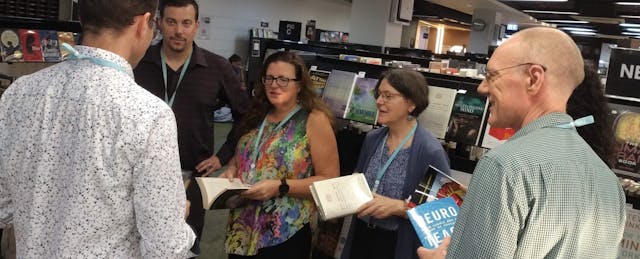Nina Radcliffe’s teaching practice was changing. The “Getting to Know and Love Your Brain” poster on her wall, which read “breathe deep into your belly to stay calm and help your PFC (prefrontal cortex) think clearly,” prompted her first graders to get their brains ready for learning. The chime she rang to remind students to take a calm breath before focusing their attention signaled that this breathing practice had become embedded into classroom culture.
Radcliffe was beginning to think more intentionally about the brain and to explicitly teach her students about how it functions. She wasn’t the only one.
Counselors at our school began using specific names of brain structures, such as the amygdala and hippocampus, when teaching learners how to self-regulate. They helped students understand how various parts of the brain impact their emotions and their learning experience.
Several teachers began regularly incorporating Jo Boaler’s YouCubed videos into math lessons, teaching students how mistakes change the brain’s wiring and provide opportunities to make new connections, which is a crucial part of the learning process. In fact, I was co-teaching in Radcliffe’s class when an emergent bilingual learner triumphantly exclaimed, “I made a mistake!” toward the end of Writer’s Workshop. Radcliffe congratulated her and the class burst into applause because they recognized the mistake would help her learn.
As an English as an additional language (EAL) support teacher at NIST International School in Bangkok, Thailand, I co-teach in four early elementary classrooms, supporting multilingual students who are developing their academic proficiency in English. My class time is somewhat reduced by my role as EAL team leader, in which I support other elementary EAL teachers.
Traveling between classrooms and across grade levels gives me insight into how teachers are changing their practices. In September 2018, I noticed a pattern emerging—multiple teachers at the school were shifting toward practices supported by Mind, Brain, and Education (MBE) research. MBE is an academic field that brings a transdisciplinary lens to the study of teaching and learning, specifically focused on the intersection of cognitive neuroscience, psychology and education.
Individual teachers were demonstrating pockets of innovative practice that leveraged MBE research and as I moved between classrooms, I wondered what it would take to scale these practices across the whole school.
I knew it was possible and that my school was ready. But I was just one teacher and I was stuck on the how. I needed someone who could help me develop a plan—I needed an advisor.
Developing a Professional Learning Community
Earlier in my career, I met Dr. Tracey Tokuhama-Espinosa, a researcher, author and thought leader in the field of MBE, when she presented a session on multilingualism at Zurich International School. As a professor at Harvard University’s Extension School—teaching the Neuroscience of Learning: An Introduction to Mind, Brain, Health, and Education—I knew Tokuhama-Espinosa would have insights into introducing MBE research to individuals with a broad range of experience and expertise.
I reached out to her in July 2019 to reconnect and ask some specific questions about scaling MBE practice in an international school. A simple question she asked led me to my next steps: “Do you have people already interested?” We did, and as we talked more, I realized there was a lot of untapped potential in our existing staff. We had strong, experienced teachers already making small changes. We just needed a venue to surface our efforts and connect them in a way that would enable others to benefit as well.
Tokuhama-Espinosa suggested forming a core group of interested staff members and to begin building a shared understanding of the principles and tenets of MBE. If we started with a strong foundation, people would be more likely to have the buy-in necessary to sustain long-term change throughout the school.
So, I put out my feelers. I posted a notice on the staff blog and emailed a few colleagues directly to see who was interested in creating an informal professional learning community (PLC) focused on MBE. To my surprise, people were interested and they voted to meet before school at 7 a.m.
I unofficially named the PLC “NeuroNIST” and planned our first session. The driving goal was to create a community of practitioners who identify as learning scientists. Together, we committed to an iterative process of examining existing and emerging MBE research and continually learning, testing, reflecting and revising our practices to make sure they’re reflective of the findings. But we took it one step at a time.
It started with coffee. For our first meeting,15 of us—including elementary and secondary teachers, learning coaches, specialists and our head of school—came together before the start of school. The participants ranged from tentative and curious to highly knowledgeable about brain development. Some needed individual encouragement to attend, while others prepared resources in eager anticipation. We prioritized creating a safe space to speak, share and ask questions openly.

I loaded the table with the best cold brew coffee in Bangkok (that was important) as well as a selection of books and articles related to MBE. The agenda included time for us to share what brought us to the meeting, review some background information about the field of MBE research, discuss our goals and collectively decide on our next steps.
The immediate key steps for this school year were to develop a common foundational understanding of how the brain learns, to identify the research-informed practices we were already implementing and to find ways to share what was working across the staff.
We agreed to meet regularly and within weeks additional members of the leadership team and teaching assistants joined our group, which now includes over 20 members. We engaged with literature immediately, selecting Tokuhama-Espinosa’s book “NeuroMyths” as our first group read. Mitch Norris, one of our learning innovation coaches, started a Padlet where NeuroNIST members could share readings that resonated with them and ideas that challenged their thinking to extend conversations beyond our limited in-person meeting time.

Though we continued reading as a large group, small interest groups also formed. A group of early elementary educators formed a group around the science of reading, and our math learning innovation coach, Deb Gibbs, began sharing studies on memory, inviting conversation about the implications for math instruction across grades. Soon, two teacher librarians created a NeuroNIST booklist in our school’s digital catalogue that enabled staff to easily locate 39 current MBE-related titles.
Expanding the Conversation
We originally set out to help students understand how their brains learn best by ensuring that we (their teachers) have a shared understanding of how the brain learns and dedicated space to engage in professional conversations that are firmly grounded in research.
It has been five months since NeuroNIST began and we’ve come a long way in terms of surfacing the research-informed best practice already happening throughout our school and opening professional dialogue to challenge and extend our thinking.
NeuroNIST members are starting to ask questions with leadership and discuss ways to ensure that professional learning experiences are evidence-based. Radcliffe reached out before a staff handwriting session, asking if there was more current brain-related research, and Gibbs included more MBE research in an upcoming staff session on teaching math using a workshop model.
Our school leaders are following suit. Our head of elementary learning support suggested that members of our PLC present at a staff meeting dedicated to debunking the most prominent neuromyths and the engagement was striking.

This work is even making its way to the parent community. Our deputy head of secondary school, Jacqueline Arce, recently used insights into memory formation, allocation, storage and retrieval to help a parent better understand the challenges their child was facing, and what strategies might help the student learn.
We’ve taken big steps toward incorporating more MBE research into instruction—but our work has just started. Our long-term vision includes creating a culture of reflective practice in which we are not only critical consumers of research, but feel empowered and capable of making decisions about how that research might best apply to our unique needs and to identify measurable ways to gauge the efficacy of our interventions and revise our approach as needed.
Over the past several months, I’ve been fortunate to engage with educators and administrators at other schools in the region, who are interested in starting a similar journey at their schools. My advice is always to start where you are, with what you have—and make sure the coffee is excellent.


